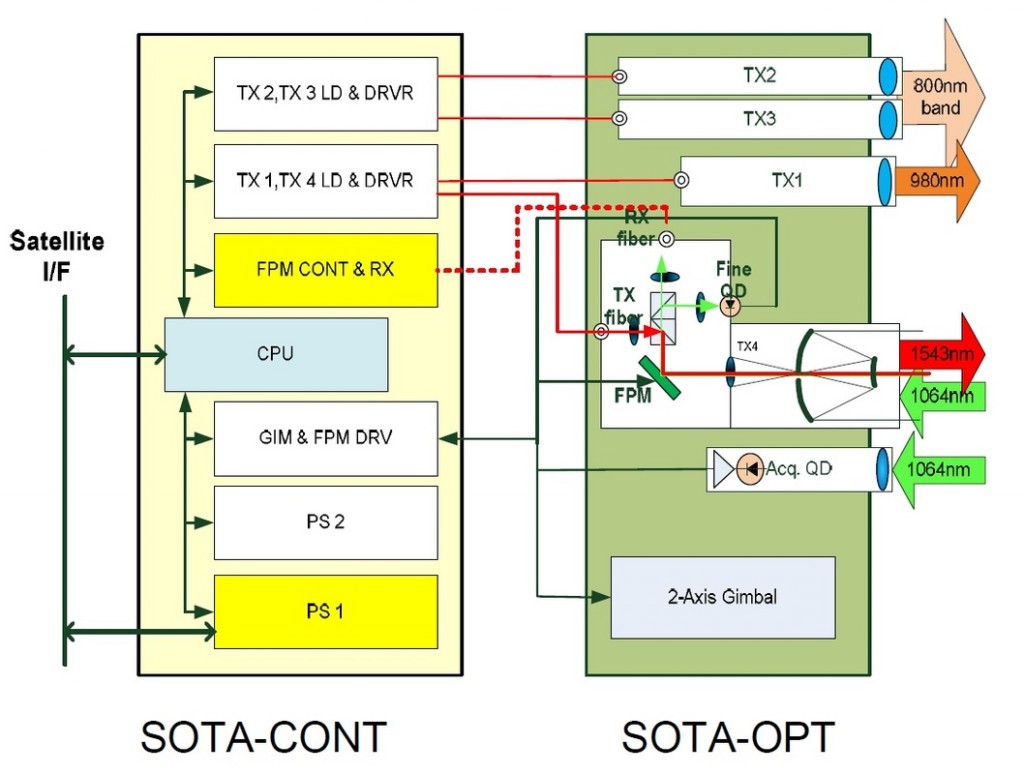SOCRATES
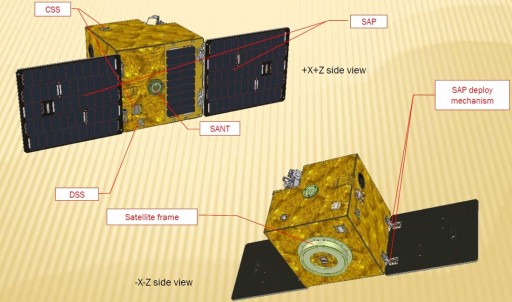
SOCRATES – the Space Optical Communications Research Advanced Technology Satellite is a microsatellite project of the National Institute of Information and Communications Technology in Japan. The primary objective of the mission is the demonstration of a Small Optical TrAnsponder SOTA – a laser communications terminal for use in space flight applications.
The SOCRATES satellite was developed by Advanced Engineering Services, Tsukuba, Japan using a small standard satellite bus. Overall, the satellite measures 49.6 by 49.5 y 48.5 centimeters in its launch configuration and 50.7 by 139.4 by 48.5 centimeters once its two solar panels have been deployed in orbit. SOCRATES weighs 48 Kilograms.
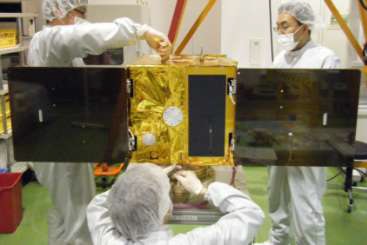
The satellite features two deployable solar panels and a smaller body-mounted solar panel, all facing the +z side of the spacecraft. The gallium-arsenide solar cells generate a total power of around 100 Watts using peak power tracking.
A Power Control Unit is used for power distribution to all other satellite systems and to control the state of charge of two onboard batteries. SOCRATES uses an Onboard Computer to control all systems functions, handle housekeeping and payload data, manage data downlink and activate/deactivate the satellite payloads.
The spacecraft uses a suite of attitude sensors including a star tracker, six coarse sun sensors, a Vibrating Structure Gyroscope Assembly and a three-axis magnetometer. Attitude actuation is provided by a reaction wheel assembly consisting of three wheels and three magnetic torquers used for momentum dumps and attitude control in safe mode. A dual-channel GPS receiver is used to acquire position information and for orbital determination.
The SOCRATES satellite uses an S-Band communications system consisting of S-Band transponders, diplexers and couplers feeding two antennas to create a redundant system for data downlink and command uplink.
SOCRATES Block Diagram
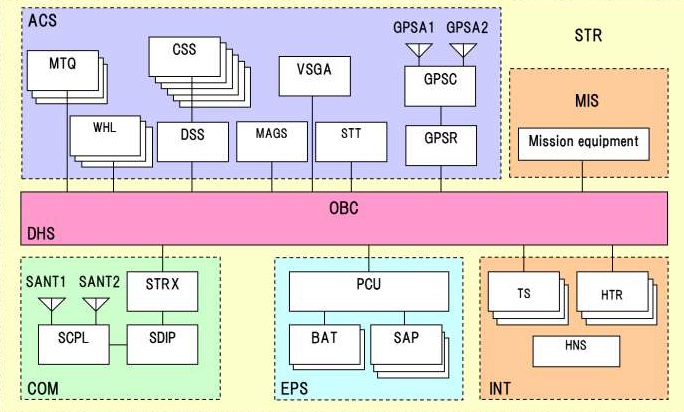
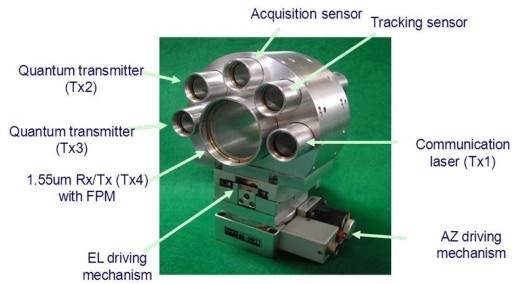
The main payload of SOCRATES is SOTA – the Small Optical Transponder that will be used to demonstrate a compact laser communications terminal for use on satellites, microsatellites and nanosatellites. The objectives of the mission are the verification of on orbit acquisition, tracking and communication performance of the small optical terminal as well as the collection of data associated with propagation through the atmosphere at various wavelenghts. SOTA will be used to assess the quality of communications using different coding, different Quantum Key Distribution techniques and different Optical Ground Stations using different equipment.
SOTA was built by NICT and industry partners NEC Corporation and NEC Toshiba Space Systems.
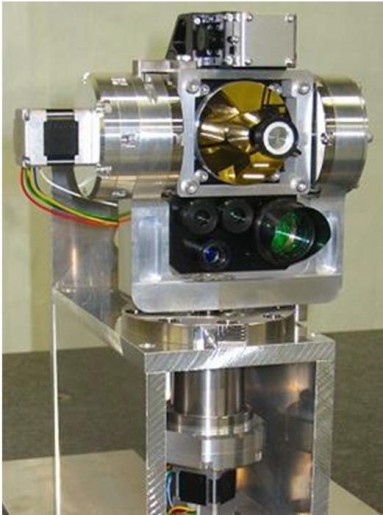
Proto-Flight Model of SOTA’s Optical Unit
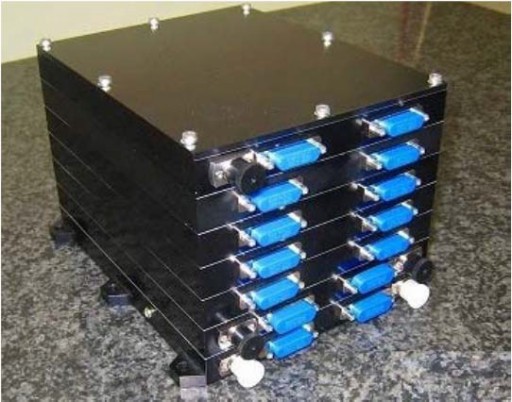
The SOTA payload consists of an optical part and an electronics box. The optical unit includes Acquisition Quadrant Detectors, receiving optics with a Fine-pointing Quadrant Detector, four laser transmitters, a fine pointing mechanism and an Avalanche Photodiode. The electronics box includes all equipment needed to control the optical head and generate the required laser signals.
Overall, SOTA weighs just under six Kilograms, its optical had measures 17.8 by 11.4 by 26.8 centimeters including an Elevation over Azimuth gimbal system that utilize Commercial Off the Shelf components. The Electronics Box measures 14.6 by 16.0 by 10.7 centimeters in size and has a maximum power consumption of 23 Watts.
The Azimuth and Elevation gimbals use a step drive motor with harmonic drive to allow an angular range of +/-50 degrees for azimuth steering and -22 to +78 degrees for elevation steering. The gimbal can be operated at up to 3 degrees per second at a resolution of 0.001125 degrees per pulse.
To locate, lock onto and track an uplink signal, SOTA uses an Acquisition and Tracking System with an aperture diameter of 2.3 centimeters that creates a field of view of +/-40 mrad and uses an InGaAs detector. Once tracking the signal with high accuracy, SOTA’s main receiver can acquire the signal since it has a narrow field of view of +/-2mrad using a Cassegrain Telescope (using a combination of a primary concave mirror and a secondary convex mirror aligned on the optical axis).
The main receiver uses a 5-centimeter aperture and an InGaAs detector. The receivers use an asynchronous uplink signal at a wavelength of 1,064 nanometers. The carrier frequency of the uplink is 40kHz with a signal bandwidth of 1kHz.
SOTA uses a total of four transmitters – TX1 and TX4 are used to transmit data while TX-2 and TX3 support quantum measurements for satellite quantum key distribution – these measurements use TX2, 3 and 4 simultaneously. The transmitters reach a data rates of up to 10Mbit/s for data downlink and 1Mbit/s for telemetry downlink.
TX1 operates at a wavelength of 976 nanometers and an average power of 217mW while TX4 operates at 1,549nm with a power of 35mW. The beam diversion for the two optical transmitters are 440 and 190 µrad, respectively. TX2 and 3 operate at 800nm
For communication demonstrations, the SOCRATES satellite will downlink images acquired by a camera installed on the spacecraft.
Testing will be performed using the AES ground station in Tsukuba, Japan and the Svalbard ground station in Norway. Planned are tests using other ground sites to check the compatibility of the system with other existing ground stations to demonstrate the feasibility of the use of optical communications on low orbiting spacecraft.
SOTA Functional Diagram
